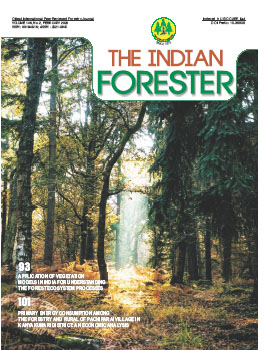Arecaceae Family in Gujarat, its Morphological Character based Identification keys
DOI:
https://doi.org/10.36808/if/2020/v146i2/140358Keywords:
Arecaceae, Cultivated Varieties, Ornamental, Wild Palms, Gujarat.Abstract
Arecaceaec family is the third largest economically important family distributed mainly in tropics and sub-tropics. In India palms are mainly distributed in three geographical regions including the Peninsular India, forest areas of Northern India and Andaman and Nicobar Islands. In the present study 39 genera and 79 species with 31 cultivated varieties include ornamental, cultivated and wild palms were reported. Maximum diversity of palms found in Ahmedabad with 74 species followed by Vadodara 26 species, Gandhinagar 24 species, Surat 22 species and others are less than 22. The genera and species are arranged in according to phylogenetic classification of the Arecaceae proposed by Dransfield et al., 2005 for easy references. Article deal with identification key based on morphological characters. Each species carries the valid name and nomenclatural references which have been encounteredin updated APG III nomenclature system.References
Basu S.K. and Chakraverty R.K. (1994). A Manual of Cultivated Palms in India. Botanical Survey oflndia, Calcutta.
Beccari O. and Hooker J.D. (1894). Palmae: In: Hooker, J.D. ed. The Flora ofBritish India.
Bhat K.G. (2012). Palms of Karnataka, Systematics of flowering plants, Systematics of Flowering Plants; 25-38.
Blatter E. (1926). Palms of British India and Ceylon. Oxford University Press, London.
Cooke T. (1907). The Flora ofthe Presidency of Bombay Vol. 3 (Botanical Survey of India, Calcutta, Reprint 1958).
David L.J. (1995). Palms Throughoutthe World, Smithsonian Books. Washington.
Dransfield J. Uhl N.W. Asmussen C.B., Baker W.J., Harley M.M. and Lewis C.E. (2005). A new phylogenetic classification of the palm family, Arecaceae, Kew Bulletin, 60: 559-569.
Ellison D.E. (2001). Cultivated Palms of the World, UNSW Press.
Kulkarni A.R. and Mulani R.M. (2004). Indigenous palms of India, Current Science, 86: 1598.
Laeus C. (1753). Species Plantarum.L. Salvii, Stockholm.
Phadtare N.R. and Kulkarni A.R. (1980). Palynological investigation of Ratnagiri lignite, Maharashtra. Geophytology, 10: 158170.
Qureshimatva U.M., Gamit S.B., Muarya R.R., Solanki H.A. and Yadav S.L. (2016). Check-list of Palms in Ahmedabad, Gujarat, India, International Journal ofRecent Scientific Research, 7(3): 9413-9417.
Renuka C. and SreekumarV.B. (2012). Palms of India, KFRI, 1
Riffle R. (2008). Pocket Guide to Palms, Timber press.
Shah G.L. (1978). Flora of Gujarat State, Sardar Patel University, Vallabh Vidyanagar, 2: 692-694.
Downloads
Downloads
Published
How to Cite
Issue
Section
License
Unless otherwise stated, copyright or similar rights in all materials presented on the site, including graphical images, are owned by Indian Forester.





